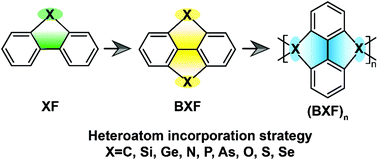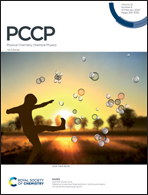Heteroatom-bridged heterofluorenes: a theoretical study on molecular structures and optoelectronic properties†
Abstract
Heteroatom incorporation is highly effective in tuning the molecular structures and optoelectronic properties of conjugated organic molecules. Here, we performed systematic theoretical studies on heteroatom-bridged heterofluorenes (BXFs) constructed by double heteroatom bridges of biphenyl to reveal the effects of heavily incorporated heteroatoms on molecular architecture and π-conjugation for different optoelectronic properties. Nine novel BXFs in three series were investigated and all of them exhibit promising potential optoelectronic properties owing to their highly fused molecular structure with heavy π-conjugation, although the introduction of different types and numbers of heteroatoms will lead to varied properties. Moreover, spiropolymers of BSiF and BGeF polymerized at the bridging position were also designed for the first time and found to have attractive optoelectronic properties of poly(BXF)s inherited from their monomers, demonstrating further the effectiveness of the bis-heteroatom introduction strategy in the construction of high-performance optoelectronic polymers. This heteroatom introduction strategy in constructing highly rigid π-conjugated materials could be applicable to other systems, representing a new concept advance to design novel conjugated small molecules and polymers for high-performance optoelectronic applications.



 Please wait while we load your content...
Please wait while we load your content...